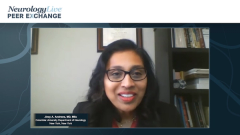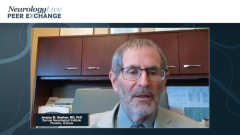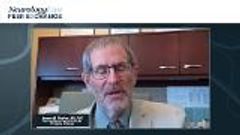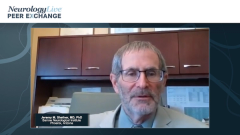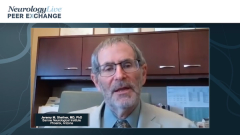
Counseling Patients on ALS Progression and Prognosis
Key opinion leaders ALS care comment on best practices when communicating with patients about the unpredictability of disease progression and prognosis.
Episodes in this series

Richard S. Bedlack, MD, PhD, MS: Jeremy, back to you. When we have a patient with a diagnosis, what can they expect? How do they change over time?
Jeremy M. Shefner, MD, PhD: Most of us see patients in a tertiary care neurology practice, so we get patients who have probably heard the term ALS [amyotrophic lateral sclerosis] before and are often coming to us hoping that will tell them something different. The first thing they hear when they come to one of us and it is in fact ALS, is that the hopes they had for some more treatable disease is not the case. So an early job for an ALS specialist is to present reasonable expectations of what is going to happen.
One of the main things that I emphasize early on is that I do not know. I clearly expect that this is a disease that will get worse over time. By getting worse, I mean the weakness or stiffness or incoordination that they have in specific parts of their body will worsen, and that will spread to parts of the body that are currently doing pretty well. Those will start becoming affected as well.
What I do not know is what is going to change next and when that is going to happen. I make a major point to say that I do not know whether the changes that I expect to see are going to happen over the next 3 months, which is probably the next time I will see them, the next year, or the next 2 years. I do not know whether they will be walking in 6 months, in a year, or in 5 years. The rate of progression in ALS is incredibly variable.
We can get some sense of that, and I then use that to talk to them about getting the history of how long they have had symptoms before they have come to see me. That gives me some idea of how aggressive the disease is, but the pace is something that is incredibly erratic, and it is somewhat reassuring to patients because we are not telling them that the average lifespan is 2 1/2 years after diagnosis, and they can expect that to happen. What we need to be telling them is that not only are there things that we can do now, but that even without that, we do not know.
We prepare them as well. The things that cause tremendous morbidity in ALS are issues with breathing, so I go through that. I talk about the things that we can do if that becomes a problem to make that more manageable. For difficulty with swallowing, there are ways to make life sustainable and worthwhile even in the face of those kinds of problems. For difficulty with ambulation, walking, and difficulty with performing a lot of the activity of daily living that we take for granted, all of those things are things that, when we see people repeatedly, we go through them and do our best to help them deal with them in positive ways. Those are the things that ultimately get discussed.
Richard S. Bedlack, MD, PhD, MS: Thank you. Ammar, the first time you see someone, can you get any hints about how they are going to do? Can you tell if a person is likely to live just a year or live 20 years the first time you see them?
Ammar Al-Chalabi, MB, ChB, PhD: I agree with Jeremy, that is a very variable condition. It is difficult to predict. We can get a feel for it if someone is showing aggressive disease or not aggressive disease so far, and that gives you some clues, but being more precise than that is difficult. The way I explain it to my patients is this: we can make mathematical models of survival, and we can even plug in the patient’s details, and it will then draw a nice probability curve of survival, but that is actually useless for an individual. It is good for groups of people.
The best way to understand it is with this example: I can make a mathematical model of how long the light bulbs will live in my house, and I could come back in 3 years and count the light bulbs and say, “Oh, 5 lightbulbs have blown, just as my model predicted.” It would be accurate for the light bulbs in my house, but if you ask me, “Will that light bulb be here in 3 years,” I cannot tell you. It is the same for individuals. Even though we can make a nice mathematical model that predicts survival on average, for an individual, it is useless. That is why we cannot tell people an accurate prognosis at all.
Jeremy M. Shefner, MD, PhD: One more thing on a more hopeful note is that we now have 2 medications that alter disease progression, and 1 medication significantly alters significant symptoms in ALS. All these drugs work to some extent; they all have modest effects. A big question is this: do these individual drugs cause modest improvements or modest declines in rate of progression for everybody, or do they cause significant reductions in rate of progression in some people and much less significant in others? I do not think we have data to prove that one way or the other. My strong inclination is No. 2, that drugs work, when they work modestly, they work better in some people than others. That also adds both to the uncertainty and the potential optimism when you first discuss this with the patient, that you do have these agents that may significantly affect their life going forward.
Jinsy A. Andrews, MD, MSc: I want to drive both Ammar and Jeremy’s points at this particular time because there is still the perception by people outside of the ALS field that ALS is fatal, and is quickly fatal for everybody. The realizations that the disease is very individual, and it has a high degree of variability in prognosis are very real.
As an example, on Monday, I was at the veteran’s hospital, and I saw a person who was diagnosed in 2017 and was told he had 6 months to live. He did not pursue any other medical care and got his affairs in order. Well, 2018 came, 2019 came, 2020 came, and now in 2021 his spouse attended a support group and found out that there is multidisciplinary care and that all these things including the treatments that Jeremy was talking about are available for him, and he finally came to the clinic. The thing is that this is still the perception. I want to drive home the fact that there is a lot of variability in prognosis, and 15% to 20% of people living with ALS can go well beyond that 5-year mark. There are a lot of things that we can do early in the disease that can impact disease progression and make people live longer and better.
Richard S. Bedlack, MD, PhD, MS: Thank you for watching this NeurologyLive® Peer Exchange. If you enjoyed the content, please subscribe to our e-newsletters to receive upcoming Peer Exchanges and other great content right in your inbox.
Transcript Edited for Clarity
Newsletter
Keep your finger on the pulse of neurology—subscribe to NeurologyLive for expert interviews, new data, and breakthrough treatment updates.

